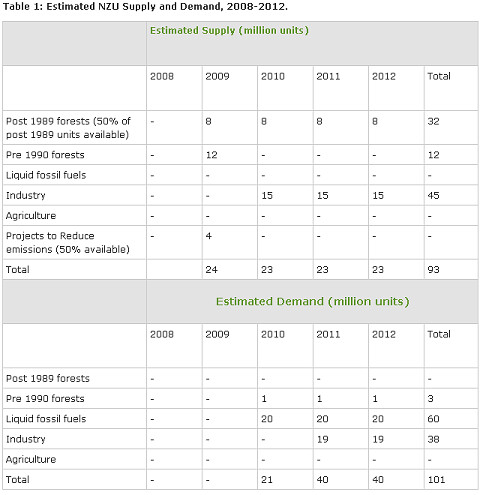In May 2008, the previous government made a spineless decision to delay the entry of transport into the ETS by two years. The decision was driven by fears of the effects of higher fuel prices on inflation, but one of the effects was to throw the supply and demand of emissions units within the ETS significantly out of balance. How far out of balance? Here's the original figures on the Supply and Demand of New Zealand Units, taken from a briefing to the Climate Change leadership Forum:

(Note that while transport enters the ETS in 2009, and industry in 2010, the first emissions units do not need to be surrendered until April of the following year, so the demand part of the graph is lagged by a year).
As designed, the ETS had a slight undersupply of units, which would either drive emissions reductions or see units purchased overseas (which is the same thing from a Kyoto accounting perspective). but the removal of two years of transport emissions - 40 million units - completely reverses this situation. instead of a slight undersupply of 8 million units over CP1, we now have a massive oversupply of 32 million units - more than half the anticipated demand. So thanks to Labour's spinelessness, our ETS is overallocated by 50%.
This has significant consequences. As the Europeans are discovering, emissions trading only works when there is a shortage of permits. Where there is an oversupply, the price collapses, fatally undermining the effectiveness of the scheme. And where permits can be "banked" (as in New Zealand) the effect is even worse, because overallocation now creates the opportunity for more emissions in the future.
But its worse than that, because in the New Zealand ETS these units can be sold overseas. This has two consequences. Firstly, it will cost us a large amount of money. Every permit sold overseas must be "backed" by a unit from New Zealand's Kyoto Assigned Amount. But our net position is seriously in deficit [PDF]. So we are going to have to buy those units back. Using Treasury's costings, that will cost us an extra NZ$807 million - more than doubling our expected Kyoto liability.
Secondly, under the Kyoto Protocol, the New Zealand government is obliged to hold back 90% of its Assigned Amount as a "commitment period reserve" (this clause was designed to stop countries from just selling their entire allocation immediately, taking the money and running). Our Assigned Amount is 309.56 million units. 90% of that is 278.61 million units. You don't need much maths to see that the difference - 30.95 million units - is less than the amount by which the ETS is overallocated. So overallocation could threaten the CPR, our credibility, and our ability to engage in international trading.
(The government has said that in the event of the CPR being threatened, it will close off trading. This creates a perverse incentive to sell immediately, so as to ensure that you can...)
This issue was not really canvassed in official advice on the decision to delay. I have now obtained the relevant briefings and Cabinet papers using the OIA, and nowhere do they consider the effects on the overall balance of units within the scheme or the effect on its environmental integrity. Treasury - the primary source of advice on the decision - was concerned primarily with inflation and flow-on threats to the introduction of the scheme at all. They noted the opportunity cost of the government holding fewer units and recognised that this meant having to buy on the international market, but they did not consider overall supply, the effect of banking on future commitment periods, or the possible threat to the CPR
If we want our ETS to work, we need to find a way of removing those units from circulation. One way is to soak them up by restoring transport to its original timetable (a phased entry, with fuel companies responsible for 30% of emissions in 2009, 65% in 2010, and 100% from 2011 onwards, significantly reduces the cost). Alternatively, the government can reduce free allocations to industry. As emissions will have dropped due to the recession, the effect of this will be to rob them of the windfall profits accruing from a mass transfer of wealth from the taxpayer. A third option is to assume permits will be banked and reduce future allocations to compensate. Neither of these options will be popular with polluters - but if we want an ETS which functions properly, we will have to choose one of them.





